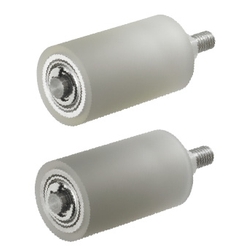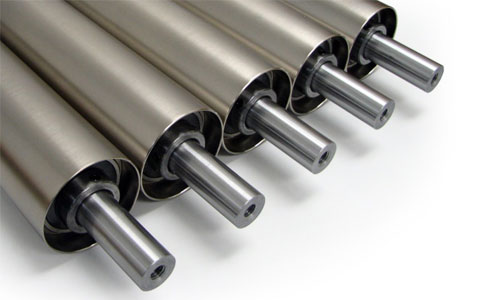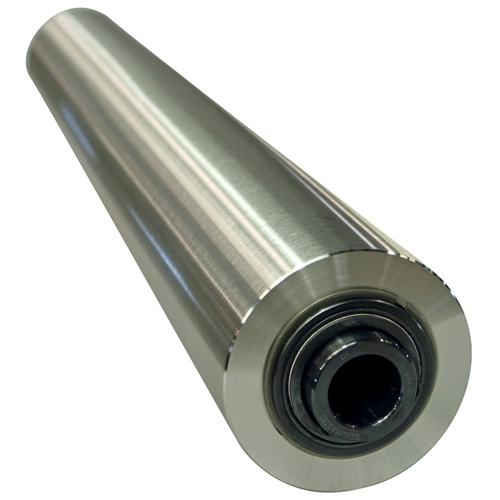Product Description
Company Profile
We are a leading manufacturer of UHMW-PE products in China since 1990’s covering an area of 58,000 square meter, we are specialized in UHMW-PE engineering plastic products research ,development, manufacture, marketing and services.
Committed to composite material conveyor roller research for more than 20 years, with more than 10 conveyor roller design patents, more than 70 sets advanced production equipment, the annual output of 1 million sets conveyor roller production capacity.
Product Description
Ultra-high molecular weight polyethylene (UHMWPE) conveyor roller/ idler is a new generation of plastic instead of steel of high-tech products, its main raw material is ultra-high molecular weight polyethylene. Ultra high molecular weight polyethylene conveyor roller has physical and chemical properties which are high wear resistance, low friction coefficient, not easy to wear leather strap. It also has the fine self lubrication and not easy to card to die in the bad conditions, antistatic, flame retardant, aging resistance, corrosion resistance. It can withstand repeated impact, vibration, mechanical performance is excellent, light weight, easy installation, no maintenance, low noise (3-7DB), smooth operation. The temperature of using keep in -40°C to+85°C.
| Basic information | |
| 1 | Brand: FJS |
| 2 | Designed Working Lift Time: 80,000hours |
| 3 | Production Capacity: as usual 1,200,000pieces/year |
| 4 | Roller Diameter: 63.5-219mm. |
| 5 | Roller Length: 100mm to 3500mm. |
| 6 | Roller Pipe: UHMWPE,Q235 carbon steel,high-precision ERW seam pipe with state-of roundness and straightness to ensure well-balanced rotation. |
| 7 | Shaft: Accurate shaft are made of cold-drawn bright round steel, which is superior in corrosion resistance and stiffness.We have strict control over tolerance of shaft dimension and surface quality.The service lifespan can be well secured and proloned. |
| 8 | Bearing: Ball bearing provided with C3 group of clearance, ZZ shield deep-groove to ensure a nice fit and off-set any expected temperature rise during operation by means of internal clearance OR according to your requirements. |
| 9 | Bearing Brand: LYC,HRB,C&U,or imported bearings or according to your requirements. |
| 10 | Seals: The Labyrinth seal structure is of non-contact type, and durable and has less rotation-resistance and long life-span as to be of optimum structure, particularly for a long-distance and large capacity conveyor for bulk material. It is approved from the testing of national authoritative organization that Seal employed is of dustproof and waterproof type, whose performance proved to be satisfactory and has by a long way exceeded the GB and JIS standard after our repeated research and development.Factory high quality greased full for life. |
| 11 | Color: black, red, blue, yellow available , or according to your requirement. |
Product Advantages
1,Belt Friendly
— extremely High Wear Resistance ,which is about 5-7 times than that of steel roller . strong ability to resist adhesive , can prolong the service life of the belt for 2-3 times.
— high self-lubrication , No Material Build Up , thus no belt miss-tracking & material spillage , less down time , greatly reduced the working accident.
— don’t absorb water , thus it will not CHINAMFG with belt under low temperature.
2,superior sealing system
Dust and water proof sealing system (Patented) ,no grease leaking , prolong the bearing’s service life.
3,noise reduction
The noise reduction material of roller , the superior sealing system , high-precision bearings , And the U-shaped ventilation groove make it a great performance in noise reduction.
4,excellent TIR rate
The roller material is more flexible to shape with precise machining , it can significantly lower the TIR rate to 0.1mm or even less , no vibration under High Speed Conveying.
5,longer service life
— High-precision bearing has longer life than normal bearing.
— great patented sealing system , don’t absorb water , no grease leaking
6,light weight
— easy to install , replace and delivery
— less power consumption , smaller motor power required and reduce the cost.
7,F.R.A.S
Flame retardant , anti-static , resistant to corrosion of all kinds of chemical medium.
Product Parameters
| NO. | Test items | Unit | Results |
| 1 | T.I.R | mm | ≤0.1 |
| 2 | Axial displacement | mm | ≤0.5 |
| 3 | Axial displacement after falling falling falling | mm | ≤1.2 |
| 4 | Axial load | KN | >15 |
| 5 | Rolling resistance | N | ≤2.5 |
| 6 | Water spray running test | g | 0 |
| 7 | Underwater running test | g | 0 |
| 8 | Coefficient of friction | – | ≤0.1 |
| 9 | Roller noise level test | dB | ≤45 |
Application
With more than 20 years’ of industry experience, we provide customized solutions concerning on specific engineering plastic requirements.
Our products are widely used in steel, smelting, coking, power industry, chemical industry, coal, cement, mining and exploration industry, oil fields, municipal engineering, Marine system, ,machinery construction, food and sports industry and so on.
Certifications
FAQ
1.Q: What’s your bearing brand?
A: Large clearance C3 ZZ type deep ball bearing with LYC,HRB or imported bearings, etc. According to customer’s requirements.
2.Q: How is your Payment Term?
A: T/T or L/C. Another payment term we can also discuss.
3.Q: Can you customize it?
A: Yes,we support customization according to your request.
4.Q: What’s the MOQ?
A: 1 piece.
5.Q: What’s the production capacity of your idler and belt conveyor?
A: Idlers 1,600,000 pcs/year.
6.Q: What’s your roller’s lifespan?
A: FJS Roller designed working life is 80,000 hours
/* January 22, 2571 19:08:37 */!function(){function s(e,r){var a,o={};try{e&&e.split(“,”).forEach(function(e,t){e&&(a=e.match(/(.*?):(.*)$/))&&1
| Material: | UHMWPE/HDPE |
|---|---|
| Application: | Chemical Industry, Mining Transport, Power Plant |
| Structure: | Comb-Type Roller |
| Bearing Type: | Double Sealed Bearing |
| Type: | Impact Idler |
| Color: | Black |
| Samples: |
US$ 1/Piece
1 Piece(Min.Order) | |
|---|
| Customization: |
Available
|
|
|---|

What maintenance practices are recommended for guide rollers to ensure optimal functionality?
Maintaining guide rollers is essential to ensure their optimal functionality and longevity. Here are some recommended maintenance practices for guide rollers:
- Regular Inspection:
Perform regular visual inspections of the guide rollers to check for any signs of damage, wear, or misalignment. Look for cracks, dents, or excessive wear on the roller surface. Inspect the mounting brackets, bearings, and axles for any looseness or misalignment. Early detection of issues can help prevent further damage and ensure the guide rollers function properly.
- Cleaning:
Keep the guide rollers clean by removing any dirt, debris, or material buildup. Use a soft brush or compressed air to gently clean the roller surfaces and remove any contaminants that may affect their performance. For stubborn residue, mild cleaning agents can be used, following the manufacturer’s recommendations. Clean guide rollers help maintain smooth operation and prevent potential issues caused by contamination.
- Lubrication:
Proper lubrication is crucial for the smooth operation and longevity of guide rollers. Follow the manufacturer’s guidelines regarding the type and frequency of lubrication required. Apply lubricants to the bearings, axles, or other moving parts as recommended. Adequate lubrication reduces friction, minimizes wear, and helps prevent premature failure or damage to the guide rollers.
- Tension Adjustment:
If the guide rollers are part of a system where tension adjustment is necessary, regularly check and adjust the tension settings as required. Ensure that the tension is within the recommended range to prevent excessive stress on the guide rollers or the conveyed materials. Proper tension adjustment helps maintain accurate alignment and prevents issues such as material slipping or misalignment.
- Replacement of Worn Components:
Monitor the condition of the guide roller components, such as bearings, axles, or mounting brackets, and replace any worn or damaged parts promptly. Worn bearings can cause increased friction, leading to reduced performance and potential damage to the guide rollers. Damaged axles or mounting brackets can affect the stability and alignment of the guide rollers. Regularly inspect and replace any worn or damaged components to ensure optimal functionality.
- Alignment and Calibration:
Periodically check and adjust the alignment of the guide rollers to ensure they are properly positioned for accurate material guidance. Misaligned guide rollers can cause material deviation, tracking issues, or increased wear. Additionally, if the guide rollers are part of a system with sensors or automated controls, calibrate the system as per the manufacturer’s instructions to maintain accurate positioning and control.
- Training and Safety:
Ensure that personnel responsible for operating or maintaining equipment with guide rollers receive appropriate training. Proper training can help operators understand the maintenance requirements, safety protocols, and best practices for guide roller operation. Promote a safety culture where operators are encouraged to report any abnormalities or concerns related to the guide rollers promptly.
By following these recommended maintenance practices, guide rollers can maintain optimal functionality, extend their service life, and contribute to efficient and reliable material handling and transport.

What safety considerations should be taken into account when using guide rollers in industrial settings?
When using guide rollers in industrial settings, several safety considerations should be taken into account to ensure the well-being of personnel and the safe operation of equipment. Here are some important safety considerations:
- Guarding and Enclosure:
Guide rollers should be properly guarded and enclosed to prevent accidental contact with moving parts. Guards and enclosures should be designed and installed in accordance with applicable safety standards and regulations. They should effectively restrict access to the guide rollers, minimizing the risk of entanglement, pinching, or crushing hazards. Adequate guarding and enclosure ensure that only authorized personnel can access the guide rollers for maintenance or inspection purposes, reducing the potential for accidents or injuries.
- Lockout/Tagout Procedures:
Lockout/tagout procedures should be implemented when performing maintenance or servicing tasks on guide rollers. Lockout/tagout procedures involve isolating and de-energizing the conveyor system, ensuring that it cannot be accidentally started or operated during maintenance activities. This prevents unexpected movement of the guide rollers, reducing the risk of personnel getting caught or injured. Lockout/tagout procedures should be strictly followed, and personnel should be trained on their proper implementation to maintain a safe working environment.
- Proper Training and Education:
All personnel involved in the operation, maintenance, or servicing of guide rollers should receive proper training and education on safety procedures and best practices. They should be familiar with the potential hazards associated with guide rollers and understand how to safely operate, inspect, and maintain them. Training should cover topics such as lockout/tagout procedures, emergency response protocols, hazard identification, and safe work practices. Regular refresher training sessions should be conducted to reinforce safety awareness and ensure that personnel stay updated with the latest safety guidelines.
- Maintenance and Inspection:
Regular maintenance and inspection of guide rollers are essential for identifying and addressing potential safety issues. Adequate lubrication, cleaning, and adjustment of guide rollers should be performed according to manufacturer recommendations. Regular inspections should be conducted to check for signs of wear, damage, or misalignment. Any identified issues should be promptly addressed to prevent accidents or equipment failures. A systematic maintenance and inspection program helps ensure that guide rollers are in proper working condition, minimizing the risk of safety incidents.
- Proper Lifting and Handling:
When lifting or handling guide rollers, proper lifting techniques and equipment should be used to prevent strains, sprains, or other musculoskeletal injuries. Guide rollers can be heavy and awkward to handle, so personnel should receive training on safe lifting practices. Appropriate lifting aids, such as hoists or cranes, should be used when necessary. Additionally, personnel should wear appropriate personal protective equipment (PPE), such as gloves or safety glasses, to protect against potential hazards during lifting and handling operations.
- Emergency Stop Systems:
Guide rollers should be equipped with emergency stop systems that allow for immediate shutdown of the conveyor system in case of an emergency or hazardous situation. Emergency stop buttons or pull cords should be strategically located and easily accessible along the conveyor line. Personnel should be trained on how to use these emergency stop systems effectively. Regular testing and maintenance of the emergency stop systems should be conducted to ensure their reliable operation during critical situations.
In summary, when using guide rollers in industrial settings, several safety considerations should be taken into account. These include proper guarding and enclosure, implementation of lockout/tagout procedures, providing adequate training and education to personnel, performing regular maintenance and inspections, following proper lifting and handling practices, and ensuring the availability and functionality of emergency stop systems. By prioritizing safety and adhering to these considerations, the risks associated with guide rollers can be minimized, promoting a safe working environment and reducing the likelihood of accidents or injuries.

Can you explain the primary functions and role of a guide roller in machinery?
A guide roller plays crucial functions and holds a significant role in machinery. Here’s a detailed explanation of the primary functions and role of a guide roller:
- Guidance and Alignment:
One of the primary functions of a guide roller is to provide guidance and alignment for moving components within machinery. It ensures that objects or materials follow a predetermined path or track, preventing them from deviating or straying off course. The guide roller’s smooth or grooved surface, along with its rotational movement, helps maintain proper alignment and prevents misalignment or unwanted movements. By guiding the motion of objects, the guide roller ensures accurate positioning and efficient operation of the machinery.
- Support and Load Distribution:
A guide roller serves as a support mechanism, carrying the weight of objects or loads within the machinery. It helps distribute the load evenly, preventing excessive stress or strain on specific components. By providing support and load distribution, the guide roller enhances the stability and overall performance of the machinery. It reduces the risk of component failures, improves operational efficiency, and extends the lifespan of the machinery.
- Friction Reduction:
Guide rollers also play a role in reducing friction within machinery. As objects move along the guide roller’s surface, the roller’s design minimizes contact friction between the object and the machinery’s components. This friction reduction helps to conserve energy and prevent excessive wear and tear on both the objects being transported and the machinery itself. By reducing friction, guide rollers contribute to smoother operation, lower maintenance requirements, and improved overall efficiency.
- Prevention of Damage and Misalignment:
The presence of guide rollers helps prevent damage and misalignment of objects or materials within machinery. By providing a designated path or track, guide rollers ensure that moving components stay in the intended position and avoid colliding with other parts of the machinery. This prevents potential damage to the objects being transported and the machinery itself. Additionally, guide rollers help prevent misalignment, which could lead to operational issues, decreased performance, and increased risk of accidents or mechanical failures.
- Noise and Vibration Reduction:
Guide rollers contribute to noise reduction and vibration damping within machinery. The rotational movement of the guide roller absorbs and dissipates vibrations generated during operation, minimizing the transmission of vibrations to other parts of the machinery. This reduction in vibration helps to maintain a quieter working environment, reduces the risk of noise-related health issues for operators, and improves overall user comfort.
In summary, the primary functions and role of a guide roller in machinery include providing guidance and alignment for moving components, offering support and load distribution, reducing friction, preventing damage and misalignment, and contributing to noise and vibration reduction. By fulfilling these functions, guide rollers enhance the overall performance, reliability, and longevity of machinery in various industrial applications.


editor by Dream 2024-04-25